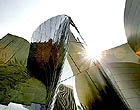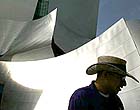reported on the proposed fix to glare and heat problems caused by architect Frank Gehry's Walt Disney Concert Hall:
This is one of my favorite of Frank Gehry's buildings (would that I could swap it with that monstrosity at the base of the Space Needle), and I'm sorry that these modifications are needed to make this building a better neighbor in its setting. The article continued:
Whoa... wait a minute here, Ms. Crouse. You've just pushed one of my hot buttons as an architect. While
architecture is art - glorious, breathtaking, uplifting art - architecture can not be seen and judged only as art. Architecture is about the creation of space, both inside and outside the
that are its end result. Architects, and the buildings they create, have an obligation to be good neighbors... not necessarily pretty, proper neighbors, but certainly not dangerous, thoughtless neighbors.
If this sort of comment came only from non-architects, I'd be happier in this profession. I was glad to read that Gehry's firm did not argue with the changes.
Hit the Dimmer, Disney Hall Is ToldBy Natasha Lee and Jack Leonard, Times Staff Writers
Officials decided Tuesday to make part of Walt Disney Concert Hall a little duller.
Construction crews are set to take hand sanders to some of the shimmering stainless-steel panels that have wowed tourists and architecture lovers but have baked neighbors in condominiums across the street.
Beams of sunlight reflected from portions of the hall have roasted the sidewalk to 140 degrees Fahrenheit, enough to make plastic sag, cause serious sunburn to people standing on the street and create a hazard to passing motorists, according to a report from a consultant hired by the county to investigate the problem.
The effort is already setting off a debate about whether it is right to alter one of Los Angeles' architectural landmarks, especially less than 1 1/2 years after the $274-million complex opened.
"It's like putting a little more hair on the Mona Lisa or making her smile a little bigger," said Denise Crouse, who takes in the spectacular view of the hall each morning on her way to work at the downtown offices of PricewaterhouseCoopers. "An artist's work should stay an artist's work."
But neighbors and office workers who stroll past the hall cheered the Los Angeles County Board of Supervisors' unanimous approval of the sanding project.
"I will just appreciate not having the glare," said condo resident Jacqueline LaGrone, who said that her air-conditioning bill had doubled during summer months since Disney Hall opened and that the glare made it impossible to sit on her patio on hot days.
"It's about time," added Sheila Nixon, a Department of Water and Power employee who regularly walks around the hall for exercise. "We feel like ants under a magnifying glass."
Architect Frank Gehry's firm agreed to the fixes, which affect 4,200 square feet of polished stainless steel panels atop the Founders Room and on the marquee above the entrance to the Roy and Edna Disney California Arts Theater, known as REDCAT.
Those sections of the hall produce the strongest glare because their sharper curves magnify the sunlight, bouncing light off each other and into a beam. Also, while most of the hall is clad in duller brushed steel, those areas are sheathed in a much more reflective polished steel. When the work is completed later this year, the sanded portions of the surface will look more like the brushed steel.
Pauline Saliga, executive director of the Society of Architectural Historians, said she doubted that the changes would drastically alter the hall's look, though she was surprised designers hadn't planned better to prevent an obvious problem such as glare in Los Angeles.
She pointed out that Gehry had to rework another landmark building, the library at Case Western Reserve University in Cleveland, after snow and ice slid off the curvy, stainless steel roof and crashed onto the sidewalk below.
"Even great architects make mistakes with materials and designs," she said. "I think you just have to admit it and you have to be pragmatic about it and alter that design if necessary. Architecture is a functional art form, so it really does have to function."
Major urban buildings such as Disney Hall routinely undergo modifications once construction is completed, said John Kaliski, a former principal architect for the Los Angeles Community Redevelopment Agency now in private practice.
"It's not that unusual to spend a certain period of time to go back and adjust things to make sure that they work," he said. "If that is the only thing that anyone can pin on this building as being somehow problematic, I would say that it's an incredible triumph."
A spokeswoman for the Music Center of Los Angeles County, which built and operates the hall, said the performing arts complex was trying to be a good neighbor.
"We put a lot of effort in to make sure that this will take care of it," said Catherine Babcock, the center's director of marketing and communications.
Workers doing the sanding will have to hang over the edge of the hall's roof to reach the affected panels above the Founders Room, an exclusive sanctuary for the wealthiest donors.
The Music Center will pick up the $90,000 tab for work on that section, which overlooks the intersection of 1st and Hope streets. REDCAT, at Hope and 2nd streets, will pick up the estimated $15,000 to $20,000 bill for sanding its marquee.
Gehry's earlier design for the hall included only dull, brushed stainless steel for its roof. But during construction, county officials said, the architect added mirror-like panels to the two sections that will now be sanded.
Officials with Gehry's firm have insisted that they took into account possible glare but that the curved panels were erected at slightly different angles than called for in their design. They did not return calls for comment Tuesday. Even before Disney Hall opened in October 2003, complaints about heat and glare surfaced, prompting the Board of Supervisors to commission a report from glare consultant Marc Schiler at a cost of $137,000.
Schiler discovered that the moaning was justified.
"There are places around some of the concave mirror surfaces where it gets quite hot," said Schiler, who teaches at the USC School of Architecture. "It's not unreasonable to believe that a lightweight plastic cone would get warm enough to sort of sag."
Schiler found that the polished panels focused beams of light into nearby intersections, causing a potential driving hazard. Using computer simulations, he concluded that the duller, brushed stainless steel caused a considerable amount of glare too, but not enough to be dangerous.
Building glare is hardly an unusual phenomenon. Indeed, Schiler said in his report that towering glass buildings along Grand Avenue, including California Plaza and the Wells Fargo Center, produced more glare than the brushed panels on Gehry's landmark.
Charlotte Epstein, a New Jersey resident who was visiting Disney Hall with her husband Tuesday, said complaints from neighbors should not prompt any changes to the sparkling landmark.
"Let them get shades," Epstein said while admiring the hall from outside. "It think it's very interesting. It's very different. I would leave it the way it is."
<- close - 



 Music and Cats
Music and Cats